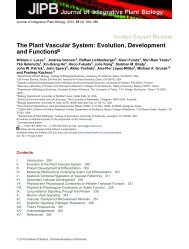A Chloroplast DNA Phylogeny of Solanum Section Lasiocarpa
A Chloroplast DNA Phylogeny of Solanum Section Lasiocarpa
A Chloroplast DNA Phylogeny of Solanum Section Lasiocarpa
You also want an ePaper? Increase the reach of your titles
YUMPU automatically turns print PDFs into web optimized ePapers that Google loves.
180 SYSTEMATIC BOTANY<br />
[Volume 29<br />
TABLE 2. Length <strong>of</strong> trnT to trnF region in studied taxa. Values are raw sequence length in base pairs, not including indels in the<br />
nal aligned version. a NA 5 Not available. First ca. 15 to 19 bp <strong>of</strong> sequence not readable.<br />
Taxon<br />
<strong>Solanum</strong> section <strong>Lasiocarpa</strong><br />
S. candidum S249<br />
S. candidum 2898<br />
S. felinum 8915<br />
S. hirtum S404<br />
S. hirtum 730<br />
S. hyporhodium 717<br />
S. hyporhodium 8214<br />
S. lasiocarpum 9605<br />
S. pectinatum 8512<br />
S. pectinatum 2899<br />
S. pseudolulo 4276<br />
S. pseudolulo 995<br />
S. quitoense 2873<br />
S. quitoense 996<br />
S. repandum 8215<br />
S. repandum 8627<br />
S. sessiliorum 458<br />
S. sessiliorum 8255<br />
S. stramonifolium 860<br />
S. stramonifolium 154<br />
S. vestissimum 456<br />
S. vestissimum S432<br />
<strong>Solanum</strong> subgenus Leptostemonum<br />
S. acerifolium<br />
S. capsicoides<br />
S. jamaicense<br />
S. mammosum<br />
S. melongena<br />
S. palinacanthum<br />
S. robustum<br />
S. sisymbriifolium<br />
S. stagnale<br />
S. tenuispinum<br />
S. torvum<br />
trnT–trnL<br />
spacer<br />
734<br />
734<br />
734<br />
738<br />
717<br />
734<br />
734<br />
752<br />
749<br />
749<br />
734<br />
734<br />
734<br />
734<br />
734<br />
734<br />
749<br />
749<br />
716<br />
716<br />
734<br />
734<br />
761<br />
752<br />
NA a<br />
731<br />
NA a<br />
716<br />
710<br />
717<br />
710<br />
717<br />
806<br />
trnL<br />
59 exon<br />
35<br />
35<br />
35<br />
36<br />
36<br />
35<br />
35<br />
35<br />
36<br />
36<br />
35<br />
35<br />
35<br />
35<br />
35<br />
35<br />
36<br />
36<br />
36<br />
36<br />
35<br />
35<br />
36<br />
36<br />
36<br />
36<br />
36<br />
36<br />
36<br />
35<br />
36<br />
36<br />
35<br />
trnL<br />
intron<br />
497<br />
497<br />
497<br />
497<br />
497<br />
497<br />
497<br />
497<br />
497<br />
497<br />
497<br />
497<br />
497<br />
497<br />
497<br />
497<br />
497<br />
497<br />
497<br />
497<br />
497<br />
497<br />
497<br />
497<br />
497<br />
497<br />
497<br />
497<br />
497<br />
497<br />
497<br />
497<br />
497<br />
trnL<br />
39 exon<br />
50<br />
50<br />
50<br />
50<br />
50<br />
50<br />
50<br />
50<br />
50<br />
50<br />
50<br />
50<br />
50<br />
50<br />
50<br />
50<br />
50<br />
50<br />
50<br />
50<br />
50<br />
50<br />
50<br />
50<br />
50<br />
50<br />
50<br />
50<br />
50<br />
50<br />
50<br />
50<br />
50<br />
trnL–trnF<br />
spacer<br />
524<br />
524<br />
677<br />
518<br />
459<br />
677<br />
622<br />
524<br />
676<br />
676<br />
677<br />
524<br />
524<br />
524<br />
524<br />
519<br />
523<br />
523<br />
753<br />
700<br />
524<br />
523<br />
639<br />
525<br />
631<br />
519<br />
462<br />
526<br />
567<br />
623<br />
462<br />
541<br />
567<br />
Total length<br />
(trnT–L to<br />
trnL–F<br />
spacers)<br />
S. wendlandii 723 36 497 50 404 1710<br />
Outer outgroups<br />
S. abutiloides<br />
S. dulcamara<br />
S. luteoalbum<br />
S. pseudocapsicum<br />
712<br />
677<br />
714<br />
NA a<br />
36<br />
36<br />
36<br />
35<br />
<strong>of</strong> the clade. 3) Within the clade described in #2 above,<br />
the two accessions <strong>of</strong> S. quitoense grouped together<br />
with 62–63% bootstrap support. 4) Also within this<br />
larger clade, S. repandum 8627 and both accessions <strong>of</strong><br />
S. pseudolulo formed a lineage. This grouping received<br />
60–63% bootstrap support.<br />
The 50% majority rule consensus trees from analyses<br />
3 and 4 (i.e., those that included indels as coded<br />
presence/absence characters) differed only in the pattern<br />
<strong>of</strong> relationships among members <strong>of</strong> section Acanthophora<br />
in the Leptostemonum clade; ingroup relationships<br />
were identical (Fig. 3). These analyses resolved<br />
the same clades as those described above with the following<br />
exceptions: 1) The two accessions <strong>of</strong> S. hirtum<br />
497<br />
497<br />
501<br />
497<br />
50<br />
50<br />
50<br />
50<br />
409<br />
413<br />
400<br />
401<br />
1840<br />
1840<br />
1993<br />
1839<br />
1759<br />
1993<br />
1938<br />
1858<br />
2008<br />
2008<br />
1993<br />
1840<br />
1840<br />
1840<br />
1840<br />
1835<br />
1855<br />
1855<br />
2052<br />
1999<br />
1840<br />
1839<br />
1983<br />
1860<br />
NA a<br />
1833<br />
NA a<br />
1825<br />
1860<br />
1922<br />
1755<br />
1841<br />
1955<br />
1704<br />
1673<br />
1701<br />
NA a<br />
did not cluster as a monophyletic group, but instead<br />
formed a grade at the base <strong>of</strong> the <strong>Lasiocarpa</strong> clade. 2)<br />
The S. stramonifolium clade emerged as sister to a<br />
group consisting <strong>of</strong> S. sessiliorum plus S. pectinatum.<br />
3) The two accessions <strong>of</strong> S. hyporhodium plus S. felinum<br />
formed a monophyletic group within the large clade<br />
described in #2 above.<br />
In general, adding the coded indel characters increased<br />
resolution on the majority rule consensus trees<br />
but decreased it slightly with respect to the strict consensus<br />
trees (i.e., in comparisons between Analyses 1<br />
vs. 4 and 2 vs. 3). This is because the indels exhibit a<br />
fair amount <strong>of</strong> homoplasy, a result also seen by mapping<br />
the coded indel characters onto the trees from
















